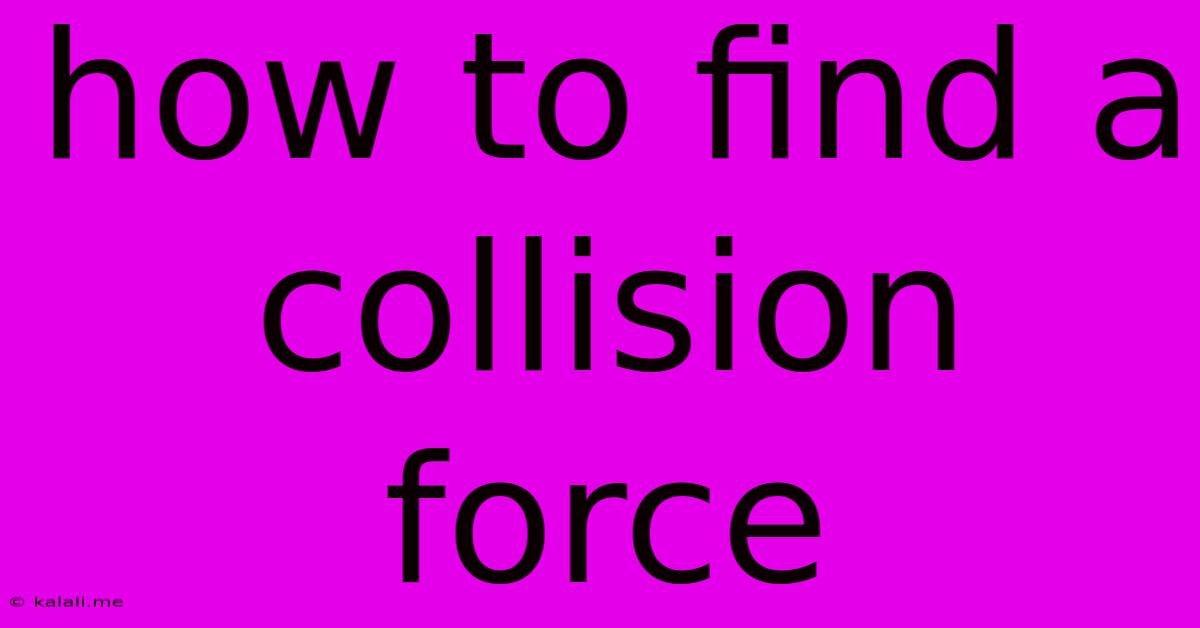How To Find A Collision Force
Kalali
Jun 08, 2025 · 4 min read

Table of Contents
How to Find Collision Force: A Comprehensive Guide
Determining the force involved in a collision is crucial in various fields, from physics and engineering to accident reconstruction and safety analysis. Understanding the factors affecting impact force and the methods used to calculate it is essential. This article explores the different approaches to finding collision force, catering to varying levels of complexity and available data. We'll cover everything from simple calculations to more advanced techniques.
Understanding the Basics: Impulse and Momentum
Before diving into specific methods, it's critical to grasp the fundamental principles of impulse and momentum. Newton's second law of motion states that force is equal to the rate of change of momentum. This forms the basis for calculating collision force. Impulse, represented as J, is the change in momentum of an object and is given by:
J = Δp = mΔv
where:
- J is the impulse (Ns)
- Δp is the change in momentum (kg m/s)
- m is the mass (kg)
- Δv is the change in velocity (m/s)
The impulse-momentum theorem states that the impulse applied to an object is equal to the change in its momentum. This relationship is vital because it directly links force and the changes in velocity observed during a collision. Because impulse is the product of force and time, and we often know the momentum change, we can work backward to find force (assuming a collision time is known or can be estimated).
Methods for Calculating Collision Force
The approach to finding collision force depends significantly on the type of collision and the available information. Let's explore several scenarios:
1. Perfectly Inelastic Collisions: In a perfectly inelastic collision, the objects stick together after impact. The calculation is relatively straightforward:
- Measure the initial and final velocities of the combined mass: This requires observation or data from sensors.
- Calculate the change in momentum (Δp): Use the formula
Δp = m(vf - vi), wheremis the combined mass,vfis the final velocity, andviis the initial velocity of the system. - Estimate the collision time (Δt): This is often the most challenging aspect, requiring high-speed cameras or estimations based on the materials involved.
- Calculate the average force (F): Use the formula
F = Δp / Δt.
2. Elastic Collisions: In an elastic collision, kinetic energy is conserved. While more complex, the principle remains the same:
- Determine the initial and final velocities of each object: Precise measurements are essential.
- Calculate the change in momentum for each object: Use
Δp = m(vf - vi)for each. - Estimate the collision time (Δt): Again, this can be difficult to measure directly.
- Calculate the average force for each object: Use
F = Δp / Δtfor each object. The forces will be equal and opposite, according to Newton's Third Law.
3. Using Coefficient of Restitution (COR): The COR is a measure of how much kinetic energy is retained after a collision. It's a useful parameter, especially when direct measurement of collision time is difficult. It’s calculated as:
COR = (relative velocity after collision) / (relative velocity before collision)
While the COR doesn't directly give force, it can help estimate the velocities after the collision, which in turn allow you to find the momentum change and ultimately the average force using the same method as above.
4. Advanced Techniques: For more complex scenarios, such as those involving multiple objects or non-uniform forces, finite element analysis (FEA) or other numerical methods may be necessary. These sophisticated techniques require specialized software and expertise.
Factors Affecting Collision Force
Several factors influence the magnitude of the collision force:
- Mass of the objects: Heavier objects generally exert larger forces.
- Velocity of the objects: Higher velocities lead to greater forces.
- Elasticity of the objects: The materials' ability to deform influences the collision time and, consequently, the force. Less elastic materials result in shorter collision times and therefore higher forces.
- Collision angle: The angle at which the objects collide impacts the force vector.
- Friction: Friction between the surfaces in contact dissipates energy and affects the collision.
Conclusion
Finding collision force is a multifaceted problem requiring careful consideration of various factors. While basic methods using impulse and momentum provide a good starting point, more advanced techniques might be necessary for complex situations. Accurate measurement of velocities and estimation or measurement of collision time are critical for reliable results. Remember to always consider the limitations of your methods and the potential for error.
Latest Posts
Latest Posts
-
Why Is My Xbox Downloading So Slow
Jun 08, 2025
-
Tracking Phases Of Design Process In A Ticketing Form
Jun 08, 2025
-
Free Backgrounds To Create Photshop Tags
Jun 08, 2025
-
Go Fast Alone Go Far Together
Jun 08, 2025
-
Thank You So So Very Much
Jun 08, 2025
Related Post
Thank you for visiting our website which covers about How To Find A Collision Force . We hope the information provided has been useful to you. Feel free to contact us if you have any questions or need further assistance. See you next time and don't miss to bookmark.